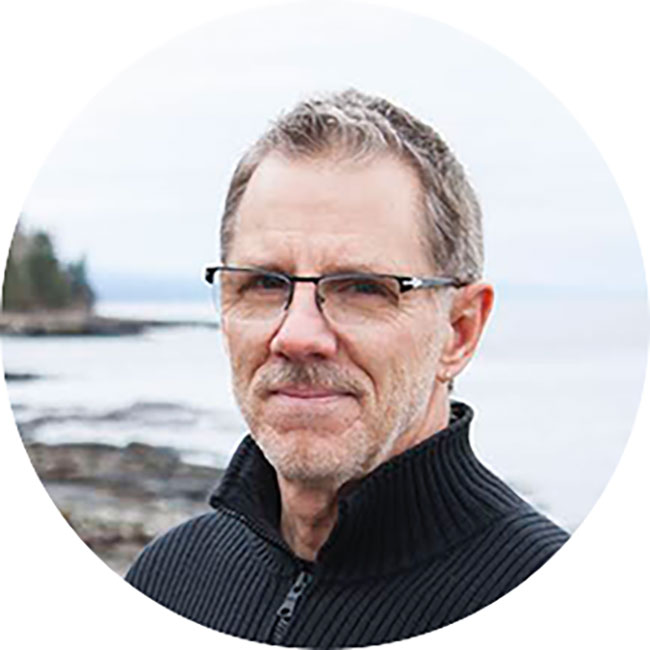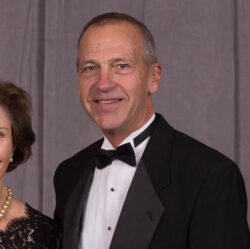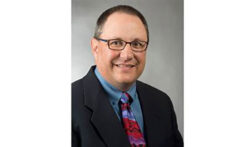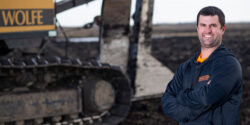
Features
Top stories of 2023: Meet the GroundBreakers
Focusing on quality of water and the quality of service
December 18, 2023 By Bree Rody
 Gary Sands
Gary Sands
For the second year of the GroundBreakers program, Drainage Contractor aimed to even up the balance of contractors and non-contractors – ensuring that the content in the program included equal perspectives from those who are driving the industry forward from the field and those who are doing so from labs and offices. This also ensured that the program stayed true to one of its key founding values: that innovation and leadership do not look like just one thing. As such, our selected honorees are: University of Minnesota’s Gary Sands, Grade Solutions’ LaVerne Weber, Iowa Soybean Association’s Chris Hay and Hands On Tiling and Excavating’s Jacob Handsaker.
The power of collaboration: Gary Sands
Gary Sands, a professor in the University of Minnesota’s department of bioproducts and biosystems engineering, is often cited as a figure of influence or valued collaborator among past and present Drainage Contractor interviewees, including 2022 GroundBreaker Bruce Shewfelt.
Sands found his way to the field of agricultural engineering through a passion for the environment, the outdoors and water in particular. That led him to an agricultural engineering program at the University of Delaware.
Of course, at the undergraduate level, Sands described his education as more “broad,” taking courses in all facets of agricultural engineering.
During those years his interest in all things water was sparked. “I don’t know what it was,” says Sands, about the specific focus on soil and water engineering. “It just really got to me. I just found it really interesting and challenging. I really found a strong interest in it, even though I’m not a farm kid at all.”
“All of us, in our basic coursework, we study irrigation, drainage and many other things related to water,” he says, but because of the “broadness” of his education, he felt he lacked the specialized knowledge in water management, hydrology and other disciplines required to become a true expert in this field.
That led him to graduate school at the University of Kentucky and, eventually, his PhD at Colorado State University, all while moving further along the path of working in drainage and water management. Following the completion of his masters, he worked for a small consulting firm in Nebraska developing software applications for irrigation and terrain analysis. “We developed a drainage application,” he says, adding that it was published in Drainage Contractor in the 1980s. The software, LandDrain, was relatively pioneering. “If you look at some of the current drainage software… we had all those features in our software back in the 1980s.”
The experience developing that software for drainage systems stuck with Sands. While he spent the 1990s working in various settings, including internationally, once he landed at the University of Minnesota in the early 2000s, he found his way back to drainage.
“In the upper Midwest, drainage is so front-and-center. I was able to dive right back in. It was almost like coming full circle.” On top of being a professor, Sands has an extension position, which allows him to spend time with farmers, contractors, agency staff and other stakeholders.
He describes these more hands-on experiences as when he gets to go “back to school” again. “We’ve got the theoretical aspects down pat pretty well, but in terms of how things really work out on the landscape, in the fields and on the farms, we learn every time we’re out there.”
When Sands first came on board at Minnesota, he says there seemed to have been “a void” for some number of years for work involving drainage, particularly in extension. At the time, there were a number of people in the contracting community, such as members of Minnesota LICA and national LICA, who wanted to ensure that there was someone involved in drainage with the extension department.
He had a goal to take stock of where the industry was and where it needed to go. Out of that need came the Drainage Research Forum. At the first Forum, individuals from Iowa State and University of Minnesota signed an MOU pledging that the states would continue their longstanding tradition of working together to advance drainage. Other individuals such as Matt Helmers and Chris Hay came on board, eventually helping expand the Drainage Research Forum to involve South Dakota.
As passionate as he is about drainage, Sands is aware that drainage is a source of nutrient losses from agricultural land. “We’re all working to reduce nutrient losses from agricultural fields.” It was following a hypothesis from the now-retired Wayne Skaggs of North Carolina State University – whom Sands describes as a “giant” in the field – that he and a team of researchers embarked on a project to prove the efficacy of shallow drainage for reducing nutrient losses through drainage. “Turns out he was right,” says Sands. Shallow drainage is not a silver bullet, but is one of the tools in what Sands calls the “suite” of conservation drainage practices. It’s a strong tool, says Sands, because it works in any area where drainage works, unlike controlled drainage or drainage management, which tend to require flat topographies.
Those tools and practices are vital, says Sands. Agricultural areas that are under irrigation and drainage are “some of the most productive systems on the planet.” Besides managing reputation, Sands says conservation practices to mitigate the unwanted effects of drainage are vital. “I think one of our biggest opportunities and challenges is to get more of those practices on the ground. I think our implementation of those practices is way lagging behind our knowledge of how they work.”
Creativity and quality: LaVerne Weber
 For many in the contracting business, growing up on a farm is a relatively typical origin story. But unlike some of his fellow groundbreakers, Weber didn’t parlay his boyhood days on a farm into a full-time career in agricultural drainage – or at least, not right away. In fact, prior to starting Grade Solutions, Weber had a full-fledged career in the roads industry. So what led him to drainage after a fruitful career in roads?
For many in the contracting business, growing up on a farm is a relatively typical origin story. But unlike some of his fellow groundbreakers, Weber didn’t parlay his boyhood days on a farm into a full-time career in agricultural drainage – or at least, not right away. In fact, prior to starting Grade Solutions, Weber had a full-fledged career in the roads industry. So what led him to drainage after a fruitful career in roads?
For nearly two decades, Weber had a successful business in the Chicago area. “Things moved forward – we had a company, we sold it.” Feeling too younug to retire, Weber knew he wanted to continue to do something similar.
It was around that time a decade ago that he became acquainted with 2022 GroundBreaker Jeremy Meiners – who nominated Weber for this year’s program – and Meiners’ family colleagues at drainage design software company AGREM. He describes Jeremy and Bob Meiners as two of his biggest mentors. “One of the things we focused on was water management,” he says, adding that Grade Solutions focuses on site development and road construction as well, but “primarily” water management.
“We’re okay with taking on innovative and challenging situations.” This includes clients for whom Grade Solutions has installed subsurface irrigation systems on hundreds of acres. Weber adds that a lot of the systems his team instals are on contour. “We’re in northern Illinois, so a lot of the topography is quite rolling. So it’s unconventional for one to think of an irrigation system on rolling ground in northern Illinois and in other places.”
Grade Solutions also “big in bioreactors.” Every irrigation system installed comes standard with a bioreactor at the end of the main, Weber explains. “So at the end of the season, we open it up to let it dewater, everything can pass through the bioreactors.” Grade Solutions also independently instals bioreactors in existing, conventional drainage systems. Currently, the company is working on placing bioreactors at drainage tile outlets to try to denitrify water going into a man-made lake. He describes this as a “thousands of acres” project. He credits Laura Christianson of the University of Illinois for her work in the field of bioreactors. “She’s coached us along and encouraged us a lot in our process,” adding that she’s helped the team modify designs to make them work for unique situations.
When they started installing bioreactors, Weber says, the company had a difficult time sourcing high-enough quality woodchips. So, he says, they played to their strengths in creativity. “We harvest and recycle our own hardwood and make our own clean chips for our bioreactors, because we want the quality and the standard to be high. It’s almost impossible to find clean-graded hardwood chips.”
One project highlighted in Weber’s nomination package was one using dairy washwater. “We have some corporate clients that have washwater from dairy processing plants and no municipal treatment facility close by. So we take that area that is nutrient-rich with nitrogen and some phosphorus too. We then connect with growers in the area, and we literally take water from their lagoons up, reutilize that, and use it through our subsurface irrigation systems.”
While Weber is proud of the creativity and flexibility Grade Solutions offers, he says the focus is, and always has been, on quality above all else. “When we formed the company, our intention was, ‘the highest quality of whatever we do for our clients,” he says, reiterating, “We like to take the best concepts that serve the people well and move forward.”
A hands-on experience: Chris Hay
 Chris Hay, senior research scientist with the Iowa Soybean Association, says he “caught the academic bug” rather quickly, which led him to his PhD at South Dakota State University. His early work focused primarily on irrigation, but he was increasingly fielding calls with questions about drainage. “I came from water-short areas, where everyone argued over too little water as opposed to too much.” He realized, eventually, that it was just another aspect of moving through soil. “As an engineer, I think I’m a problem solver, and when there’s a problem, I want to solve it.” Drainage was relatively new to South Dakota at the time, and one of the problems he saw was a lack of knowledge. At the time, his drainage knowledge came mainly from an undergraduate course, but it was through mentors in the field of drainage – including Sands – that Hay eventually rose to become a prominent voice in the Midwest agricultural drainage scene, teaching drainage to students as well as farmers and contractors through extension, and aiding in the design of drainage systems and the development of drainage practices.
Chris Hay, senior research scientist with the Iowa Soybean Association, says he “caught the academic bug” rather quickly, which led him to his PhD at South Dakota State University. His early work focused primarily on irrigation, but he was increasingly fielding calls with questions about drainage. “I came from water-short areas, where everyone argued over too little water as opposed to too much.” He realized, eventually, that it was just another aspect of moving through soil. “As an engineer, I think I’m a problem solver, and when there’s a problem, I want to solve it.” Drainage was relatively new to South Dakota at the time, and one of the problems he saw was a lack of knowledge. At the time, his drainage knowledge came mainly from an undergraduate course, but it was through mentors in the field of drainage – including Sands – that Hay eventually rose to become a prominent voice in the Midwest agricultural drainage scene, teaching drainage to students as well as farmers and contractors through extension, and aiding in the design of drainage systems and the development of drainage practices.
It was through that hands-on work with extension and other collaborators that Hay decided he wanted to be a bit “closer to the ground.” In 2015, he departed South Dakota State for the Iowa Soybean Association, which gave him a chance to continue to perform research on topics such as edge-of-field practices while also working with farmers and contractors.
One of the current applied research topics he’s working on is drainage water recycling, which he describes as exciting because he gets to combine his two areas of expertise. “There’s been this revived interest in capturing drain water and using it as irrigation,” adding that there are benefits to water quality.
Public education remains a key pillar of the organization. He witnesses firsthand the efforts that contractors are making to mitigate negative effects from drainage. “When we drain more water, nitrate is gonna come with that,” he acknowledges. “Efforts around edge-of-field practices and doing things as responsibly as possible, contractors becoming aware of opportunities with managing drainage water… There’s still work to do, but we are making progress.
Drainage had a “bad name” for a long time, says Hay, and while the industry is in many ways “still trying to overcome that black eye from when we went from paying people to put drainage in as a conservation practice to saying ‘no, we don’t want to do that anymore.’”
As progress is made, Hay also finds the work not only rewarding, but also fun. “I get excited because there are so many win-win situations we can create with these practices.”
Leading the way: Jacob Handsaker
 There probably isn’t a more appropriate name for Jacob Handsaker’s family business than Hands On Excavating and Tiling. It was a hands-on attitude that led the Handsakers to get into the business.
There probably isn’t a more appropriate name for Jacob Handsaker’s family business than Hands On Excavating and Tiling. It was a hands-on attitude that led the Handsakers to get into the business.
In 2008, Handsaker was at home farming with his brother, father and two uncles on his fifth-generation family farm. Eventually, more of his cousins wanted to come home to work. While crop markets were high at the time, he says there still wasn’t enough work for everyone. The family took the opportunity to diversify. “We’d had a backhoe for years,” Handsaker explains, “We had a family friend I worked for doing excavating work through high school living down in Missouri. When the 2008 bubble burst, he was looking for other things to do, so he came up and taught us to get the ball rolling. It blossomed from there.”
While Iowa is a major drainage market, Handsaker says at the time, there wasn’t a smaller business filling the area’s need for tiling and excavating, which was what led the company to thrive. These days, Hands On is “pretty busy.” The company places an emphasis on proactivity, “trying to head off problems before they start… Our approach is a proactive approach, rather than a reactive approach.”
Proactivity also applies to Hands On’s approach to water quality. “When the Iowa Nutrient Reduction Strategy started 10 years ago, we made a commitment to look at that and see that that’s going to be the future.” He says the company knew they’d be involved “whether we liked it or not,” and chose to lean into it hard and focus on that. “It’s paid dividends for us.”
Handsaker has worked in partnership with various agencies and initiatives such as the Agricultural Drainage Management Coalition (ADMC), the Iowa Agricultural Water Alliance and the Iowa Department of Agriculture and Land Stewardship (IDALS)’ Batch and Build program. “We’d been doing these [installations] for several years before the Batch and Build program came in, but it was the farmer taking the lead, and it took so long, and it wasn’t efficient for the farmer. We had customers who were waiting up to three years for a simple design on a bioreactor.” The program took that out of the hands of the farmer, says Handsaker.
Handsaker says the company’s involvement with organizations isn’t to set them apart competitively, but to set a good example and do some good. “We all need clean water to drink, to recreate in, for our livelihoods. These organizations, they’re really focused on that, and being a part of these organizations takes us to a level at which we’re able to learn and motivate others to be involved – maybe kind of leading the way.”
Contractors “really can do these things,” says Handsaker, who is glad that more contractors are displaying that leadership and involving themselves in such organizations. Handsaker has valued his own mentors, including Matt Helmers, and loves to pay it forward as a mentor himself. “I get calls from quite a few contractors in different states, even, they say, ‘we’ve heard about this, we’ve seen you on social media, tell me about this.’ That really shows me that Iowa is leading the way in these processes.” DC
Print this page